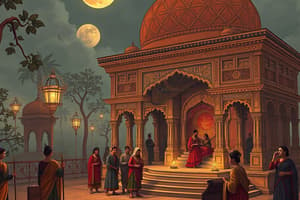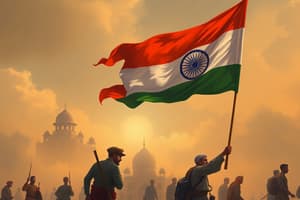Podcast
Questions and Answers
What impact did the Quit India Movement have on the freedom movement's agenda?
What impact did the Quit India Movement have on the freedom movement's agenda?
How did newspapers respond to government press controls during the Quit India Movement?
How did newspapers respond to government press controls during the Quit India Movement?
What was the main outcome of the Quit India Movement on public morale?
What was the main outcome of the Quit India Movement on public morale?
Why was the underground publication of revolutionary literature significant during the Quit India Movement?
Why was the underground publication of revolutionary literature significant during the Quit India Movement?
Signup and view all the answers
In what year did India eventually gain independence as a result of movements like the Quit India Movement?
In what year did India eventually gain independence as a result of movements like the Quit India Movement?
Signup and view all the answers
What was the primary objective of the Quit India Movement?
What was the primary objective of the Quit India Movement?
Signup and view all the answers
When was the Quit India Movement launched?
When was the Quit India Movement launched?
Signup and view all the answers
How did the Quit India Movement respond to British rule?
How did the Quit India Movement respond to British rule?
Signup and view all the answers
What did the Quit India Resolution demand from the British government?
What did the Quit India Resolution demand from the British government?
Signup and view all the answers
How did the British government respond to the Quit India Movement?
How did the British government respond to the Quit India Movement?
Signup and view all the answers
In what areas did the Quit India Movement aim to promote parallel governments?
In what areas did the Quit India Movement aim to promote parallel governments?
Signup and view all the answers
Study Notes
The White India Movement: The Quit India Campaign
The Quit India Movement, also known as the August Kranti or India August Movement, was a significant event in India's fight for independence. Launched on August 8, 1942, during World War II, the movement was a direct response to Gandhi's rallying cry, "Do or die".
Background and Significance
The movement was officially initiated by the Indian National Congress (INC) under the leadership of Mahatma Gandhi. Its primary objective was to convince the British government to grant India independence immediately. The Quit India Resolution, passed by the Congress Working Committee on August 8, 1942, demanded:
- An immediate end to British rule.
- A commitment to defend India against all forms of imperialism and fascism.
- The formation of a provisional government of India after British withdrawal.
The movement aimed to nonviolently pressure the British government by:
- Encouraging civil disobedience against the British rule.
- Upholding the Indian National Army's efforts to fight against the Japanese in Southeast Asia.
- Promoting parallel governments in areas like Ballia, Tamluk, and Satara.
Response to the Quit India Movement
The British government, alarmed by the movement's scope, reacted harshly. They arrested Gandhi and nearly all INC leaders, while thousands of supporters were imprisoned or detained. Despite the heavy-handed suppression, the movement had a profound impact on India's independence struggle. It placed the demand for complete independence at the top of the freedom movement's agenda, enhanced public morale, and increased anti-British sentiment.
Political Mobilization and Underground Literature
The Quit India Movement led to the underground publication of revolutionary literature, which further strengthened the movement's resolve. Newspapers were instructed to protest press controls by ceasing publication, and the government's campaign to persuade British-owned and edited newspapers to report news of the movement in a pro-government light was largely unsuccessful.
In summary, the Quit India Movement was a pivotal moment in India's fight for independence. Despite the British government's harsh response, the movement forced the issue of India's freedom to the forefront of world politics and paved the way for India's eventual independence in 1947.
Studying That Suits You
Use AI to generate personalized quizzes and flashcards to suit your learning preferences.
Description
Test your knowledge on the Quit India Movement, a significant event in India's struggle for independence launched on August 8, 1942, under the leadership of Mahatma Gandhi. Learn about the movement's objectives, impact, and key strategies used to pressurize the British government.




